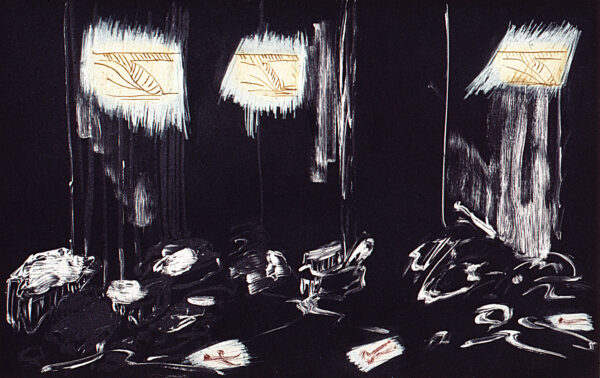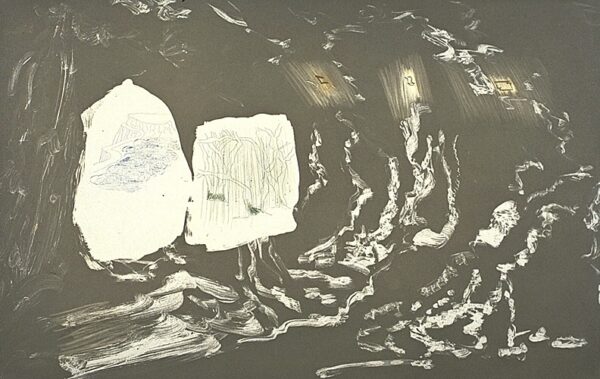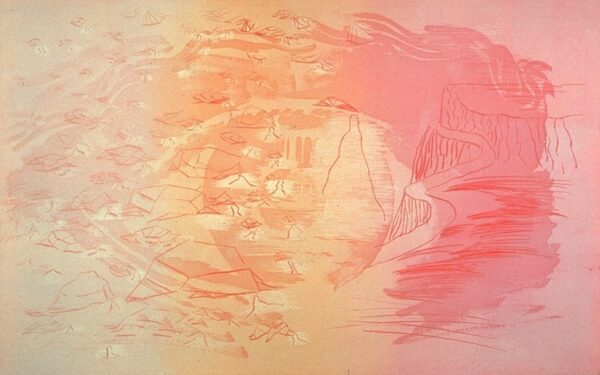Per Kirkeby (1938–2018) was born in Copenhagen. He obtained a Master of Arctic Geology degree from the University of Copenhagen in 1964 while also studying painting, graphic arts, film and performance art at the Experimental Art School. After graduating, he became involved with the Fluxus art movement, an international group that originated in 1960 and promoted artistic experimentation. Kirkeby was drawn to the group’s non-traditional and “anti-art” practices. In 1964 he began Car Pictures, a series of mixed media paintings on Masonite board depicting fragments of cars and landscapes. This series was shown at his first one-person exhibition at the Hovedbibliotek, Copenhagen, in 1964. His paintings from the late 1960s combine recognizable American and British Pop Art images with abstract blocks of color and landscape.
Kirkeby published his first book of poetry, Copyright, in 1966 and first novel, 2, 15, in 1967. In his lifetime he published over 70 books of poetry and essays on art and produced 24 short films, his earliest being Brigitte Bardot in 1968. In the 1970s Kirkeby became interested in using recycled bricks to make sculptures that would engage with their landscape. The first sculpture he made was shaped like a house; the work that followed usually incorporated aspects resembling windows, arches, corridors and doorways. There are now over fifty brick sculptures throughout Europe. In 1977, his paintings, writing, and sculptures were shown at his first significant exhibition abroad at the Museum Folkwang, Germany.
In 1981, Kirkeby took part in the important exhibition A New Spirit in Painting at the Royal Academy in London. At that time, he began exploring his geological background through his paintings. He used the materiality of oil paint to evoke structure, erosion and layers of the earth. Donald Kuspit, writing for Artforum, describes his paintings as an “ingenious blend of chaotic (expressionist) dynamics and chaotic (abstract) harmony—[he] shows us the uncanny resemblance between the eccentric patterns of seemingly formless inorganic matter and those of living organisms, the former appearing to foreshadow the latter.” Kirkeby worked to record the cycles of life and nature in his paintings.
Kirkeby received many prestigious awards including the Ars Fennica Award of the Henna and Pertti Niemistö Art Foundation (1993); the Coutts Contemporary Art Foundation Award (1996); the Henrik-Steffens-Award (1996); and the Herbert-Boeckl-Preis for his life’s work (2003). Major retrospectives of his work were held at the Tate Modern, London (2009) and the Museum Kunst Palast in Dusseldorf, Germany (2010). His work is in the public collections of the Tate Gallery, London; the Metropolitan Museum of Art, New York; the Museum of Modern Art, New York; and the Centre Pompidou, Paris. He has held professorships at the Art Academy, Karlsruhe (1978-1983); the Hochschule der Künste, Berlin (1983-1989); and the Städelschule, Frankfurt am Main (1989-2000). Kirkeby lived and worked in Copenhagen, Læsø and Arnasco until his death in May 2018. His art is represented by Michael Werner Gallery in New York, London, and Germany.
-Courtney Sennish, Crown Point Press




